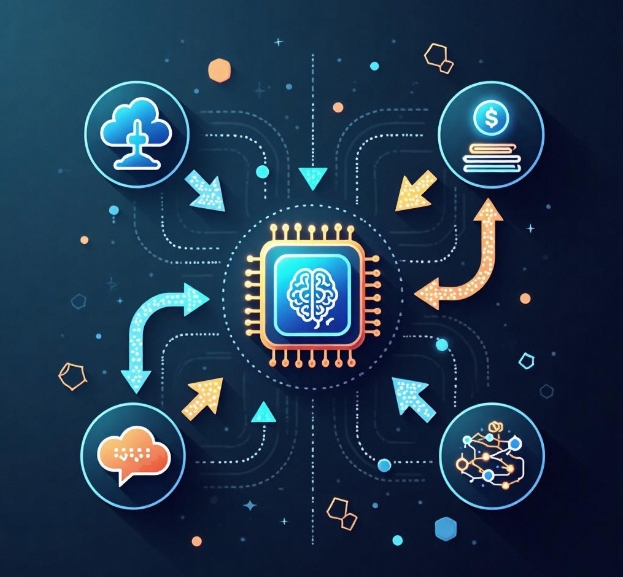Shenzhen Education Course Mall Development (Knowledge Payment)
- latest articles
- 1.DApp Development & Customization: Merging Diverse Market Needs with User Experience 2.Analysis of the Core Technical System in DApp Project Development 3.How to achieve cross-chain interoperability in Web3 projects? 4.How does the tokenization of points reconstruct the e-commerce ecosystem? 5.How to Set and Track Data Metrics for a Points Mall? 6.What is DApp Development? Core Concepts and Technical Analysis 7.Inventory of commonly used Web3 development tools and usage tips 8.Development of a Distribution System Integrated with Social E-commerce 9.Six Key Steps for Businesses to Build a Points Mall System 10.What is DApp Development? A Comprehensive Guide from Concept to Implementation
- Popular Articles
- 1.Future Trends and Technology Predictions for APP Development in 2025 2.Analysis of the DeFi Ecosystem: How Developers Can Participate in Decentralized Finance Innovation 3.From Zero to One: How PI Mall Revolutionizes the Traditional E-commerce Model 4.DAPP Development | Best Practices for Professional Customization and Rapid Launch 5.Recommended by the Web3 developer community: the most noteworthy forums and resources 6.From Cloud Computing to Computing Power Leasing: Building a Flexible and Scalable Computing Resource Platform 7.How to Develop a Successful Douyin Mini Program: Technical Architecture and Best Practices 8.Shared Bike System APP: The Convenient Choice in the Era of Smart Travel 9.How to Create a Successful Dating App: From Needs Analysis to User Experience Design 10.From Design to Development: The Complete Process of Bringing an APP Idea to Life
With the development of internet technology and the increasing demand for knowledge, online education has gradually become a trend, especially in Shenzhen, a frontier city for technological innovation. In recent years, the education market in Shenzhen has been continuously evolving, with more and more educational institutions and entrepreneurs choosing to enter this field, creating educational course marketplaces and offering various knowledge-based paid services. This article will explore the development of Shenzhen's educational course marketplaces, analyzing aspects such as market demand, technical implementation, user experience, and future development, aiming to provide insights and references for professionals in the education industry.
I. Market Background of Shenzhen's Educational Course Marketplace
Shenzhen, as a window to China's reform and opening-up, has always been at the forefront of technological innovation, attracting a large number of innovative talents and technology companies. In this rapidly developing city, knowledge-based payments have become an important consumption model, especially in the education sector. According to statistical data, China's online education market has continued to grow in recent years, with the demand for knowledge-based paid courses increasing significantly. This provides a vast market space for Shenzhen's education industry.
From traditional classroom teaching to today's online education, the form of education has undergone revolutionary changes. Particularly during the pandemic, many people began relying more on online courses to enhance their knowledge and skills. As a dual hub for education and technological innovation, Shenzhen not only has a large consumer market but also a group of leading technology companies that can provide technical support for the development of educational course marketplaces.
II. The Rise of Knowledge-Based Payments and Their Advantages
The concept of knowledge-based payments has rapidly gained traction in recent years, especially against the backdrop of rapid advancements in information technology, with an increasing number of users on online education platforms and paid courses. Knowledge-based payment platforms offer users a more flexible and convenient way to learn, freeing them from the constraints of traditional offline classrooms and enabling them to access knowledge anytime, anywhere through devices like smartphones and computers. For Shenzhen's educational course marketplaces, the knowledge-based payment model presents significant market potential.
1. Flexibility and Convenience
Traditional education is often limited by time and space, requiring students to attend classes in specific classrooms, which is inconvenient for many. Knowledge-based paid courses break these limitations, allowing users to choose suitable courses based on their needs and learn at any time and place. This flexibility and convenience attract a large number of learners.
2. Accumulation of High-Quality Content
Many knowledge-based payment platforms feature courses created and taught by industry experts, scholars, or experienced professionals. Compared to traditional education, the content on these platforms is often more professional and in-depth. This enables users to access more valuable learning resources, improving learning efficiency.
3. Personalized Learning Paths
Knowledge-based payment platforms typically offer personalized learning paths, allowing users to select different courses based on their interests and needs. This personalized learning approach helps users quickly acquire knowledge or skills in a specific field.
III. Key Technologies for Developing Shenzhen's Educational Course Marketplace
As a hub of technological innovation, Shenzhen possesses strong technical capabilities, providing ample technical support for the development of educational course marketplaces. Developing an efficient and user-friendly educational course marketplace involves multiple technical aspects, including but not limited to front-end development, back-end development, and payment system integration. Below are some key technologies in the development of educational course marketplaces.
1. Front-End Development Technologies
Front-end development for educational course marketplaces primarily refers to the interactive interface between users and the platform. To enhance the user learning experience, the marketplace's interface design needs to be simple, intuitive, and easy to operate. Commonly used front-end technologies include HTML5, CSS3, JavaScript, and front-end frameworks like React and Vue. With the development of mobile internet, front-end development for educational course marketplaces also needs to be compatible with various mobile devices, making responsive design an important consideration.
2. Back-End Development Technologies
The back-end is the core system supporting the operation of educational course marketplaces, involving data storage, user management, course management, payment systems, and more. Back-end development typically uses programming languages like Java, Python, and PHP, combined with database management systems such as MySQL and MongoDB for data storage. Additionally, the back-end needs to integrate payment interfaces like Alipay and WeChat Pay to ensure users can purchase courses smoothly.
3. Streaming Technology for Video Courses
Video courses are a core component of educational marketplaces. Ensuring smooth and clear video playback, capable of seamless viewing under different network conditions, is a technical challenge that must be addressed during development. Streaming technology can optimize video loading speeds through methods like segmented transmission and caching, ensuring video content remains unaffected by network fluctuations.
4. Big Data Analysis and Artificial Intelligence
As the number of users increases, educational course marketplaces need to handle large amounts of data. Through big data analysis, platforms can gather information on users' learning habits and course preferences, thereby optimizing course recommendation systems. The introduction of artificial intelligence enables intelligent recommendations, helping users more efficiently find courses of interest and improving learning efficiency.
IV. User Experience Design and Interaction
In the development of educational course marketplaces, user experience design is crucial. A good user experience not only attracts users to the platform but also enhances their learning outcomes. Below are some key points in user experience design:
1. Simple and Intuitive Interface
When users enter the marketplace, the first thing they encounter is the interface. Therefore, the interface design needs to be simple and intuitive, allowing users to quickly find the content they want. Course categorization, search functionality, and recommendation systems should be designed clearly and understandably, making it convenient for users to browse and select courses.
2. Smooth Payment Process
A seamless payment system is a critical factor when users purchase courses. The marketplace needs to offer multiple payment methods and ensure the security and convenience of the payment process. Feedback after successful payments should also be clear and explicit, giving users a clear understanding of the purchase process.
3. Personalized Recommendations
To enhance the user experience, educational course marketplaces can use data analysis and artificial intelligence to recommend courses that users may find interesting. Based on users' browsing history and learning habits, personalized recommendations help users quickly find suitable learning resources, avoiding wasted time on uninteresting courses.
4. Social and Interactive Features
Educational course marketplaces are not just one-way learning platforms; they can also incorporate social and interactive features to encourage user interaction and communication. For example, features like comment sections, Q&A areas, and study groups can increase user engagement and enhance learning outcomes.
V. Future Development Trends
With continuous technological advancements and evolving educational concepts, the future development trends of Shenzhen's educational course marketplaces are becoming increasingly diverse.
1. Cross-Platform Integration
With the proliferation of mobile internet and multi-screen devices, educational course marketplaces will gradually achieve cross-platform integration, allowing users to learn on different devices such as smartphones, tablets, and computers, enhancing convenience and flexibility.
2. Diversification of Content
Future educational course marketplaces will not be limited to video courses but may also include more diverse forms of educational content, such as live classes, interactive courses, and gamified learning. The formats of course content will become more varied to meet the needs of different users.
3. Intelligent Learning
The continuous development of artificial intelligence will make educational course marketplaces more intelligent. Features like personalized recommendations, intelligent Q&A, and AI tutoring will gradually become widespread, making learning more efficient and personalized.
VI. Conclusion
As a center of technological innovation in China, Shenzhen has unique advantages in the development of educational course marketplaces. From market demand to technical support, and from user experience to future development, Shenzhen's educational course marketplaces are continuously evolving and optimizing. For professionals in the education industry, understanding market trends, seizing technological development opportunities, and enhancing user experience will be key to success.
-

How does the tokenization of points reconstruct the e-commerce ecosystem?
With the continuous advancement of internet technology and the gradual prolifera···
-

How to Set and Track Data Metrics for a Points Mall?
With the rapid development of the e-commerce industry, points malls, as a common···
-

Development of a Distribution System Integrated with Social E-commerce
With the rapid development of internet technology, the e-commerce industry has e···

 Blockchain
Blockchain












